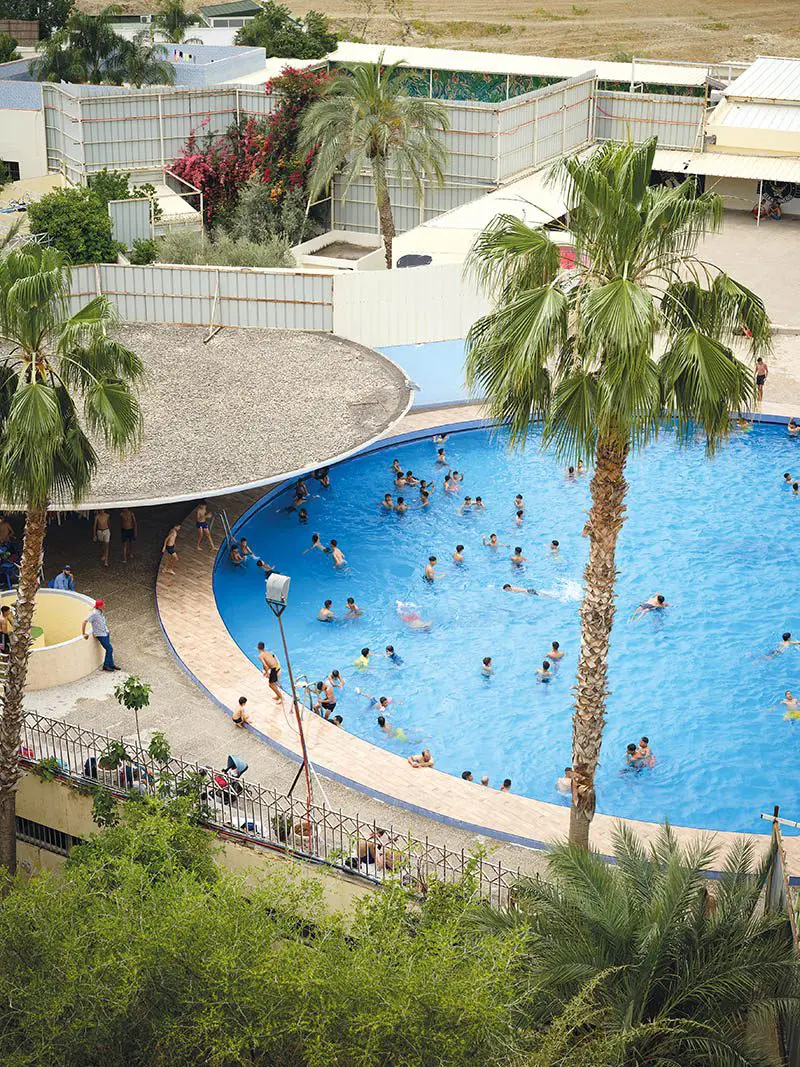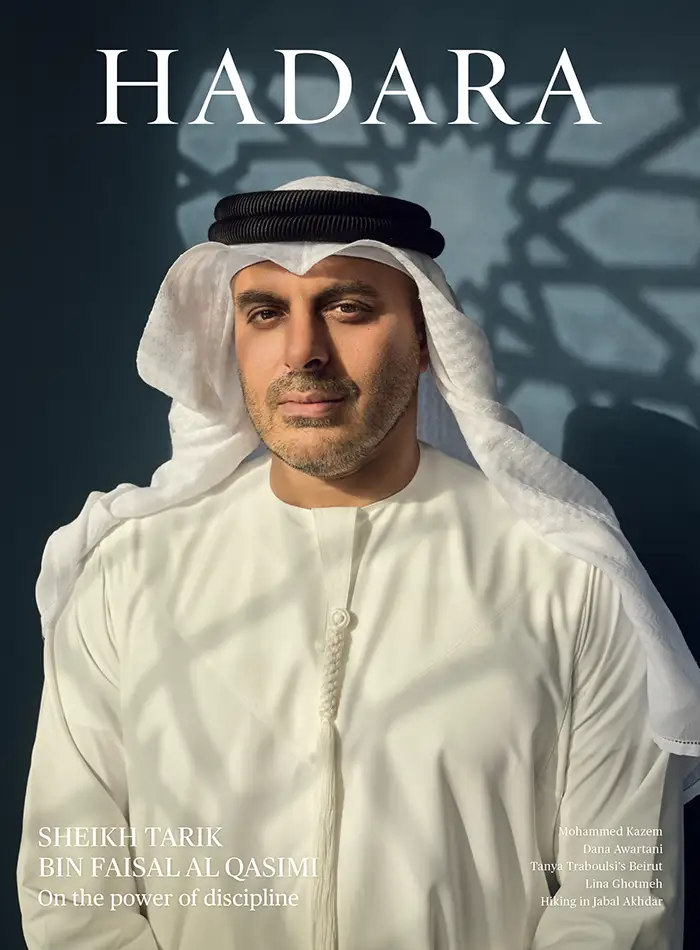Back to the future
A masterpiece of Moroccan modernism gets a new lease of life.
By Warren Singh-Bartlett
PHOTOGRAPHS BY YOUNES BOUNHAR/DOUBLESPACE
Fez. The name conjures images of zellij tiles and muqarnas, of souks and hammams—a city steeped in tradition, history, and architecture rich in ornamental detail. But soon, Morocco’s first imperial capital may also inspire visions of cantilevered concrete cubes, saucer-shaped pools, and floating staircases—forms that, in the words of architect Aziza Chaouni, “look like Star Wars”.
This outpost of the Galactic Empire on Earth lies 15 kilometres to the east of Fez, at Sidi Harazem, where a 14-hectare thermal bath complex of raw concrete structures has been decaying quietly for decades.
“It was the main tourist project commissioned by the young Moroccan state three years after independence,” says Chaouni, who has spent the past 24 years fighting to preserve the site. “It was for Moroccans and built by Moroccans.”
When Sidi Harazem was first proposed, this would still have been a radical statement. “People often speak about the colonial period as if architecture was completely apolitical,” Chaouni explains. “Whereas actually, it was extremely segregationist. Moroccans and Europeans were expected to live differently.”
In 1959, Morocco was just emerging from four decades of French colonialism and, like many of its counterparts in the Global South, it was eager to assert its modernity. Sidi Harazem, with its Brutalist hotel, marketplace, bungalows, spectacular pools, and concrete water channels, was a built manifesto of independence.
This was not only about following the dominant global trend shaping Brave New cities like Brasilia and Chandigarh, but also about affirming Moroccan identity and reclaiming architectural authorship and the claim to modernity eclipsed by colonial rule. “After all, for centuries the cities of Al-Andalus, built by North African architects, were some of the most advanced in Europe,” says Lahbib El Moumni, co-founder with Imad Dahmani of Mamma, an NGO dedicated to promoting the work of a pioneering generation of modern Moroccan architects.
Work began in 1960, a year dominated by tragedy. In February, an earthquake had devastated Agadir, killing thousands, destroying the historic medina, and leaving 35,000 homeless. Rebuilding was a trial-by-fire for the young nation and would birth a generation of architects who would not only work in the modernist vocabulary, but by aligning it with climate and cultural context, particularly in terms of the use of space, materials, and crafts, create a modernism with Moroccan characteristics


In 1959, Morocco was emerging from four decades of French colonialism. Sidi Harazem, with its Brutalist hotel, marketplace, bungalows and pools, was a built manifesto of independence. Zevaco’s architectural honesty, manifest in exposed steel beams and rugged, sun-blasted expanses of raw concrete shaped into gravity-defying forms, was nevertheless grounded in vernacular architecture. Aziza Chaouni, above, photographed by Andreea Muscurel.
Until independence, there were only three registered Moroccan architects—Abdelkader Fares, Elie Azagury, and Abdeslem Faraoui. They were joined in Agadir by trainees and European architects who had chosen to remain, among them Claude Verdugo, Emile Duhon, and Jean-François Zevaco.
“Agadir was a training ground for architects, urban planners, landscape architects, construction companies, and even the state,” El Moumni says. “They created an urban code. There could be different typologies; the concrete should not be covered entirely; buildings should show their structure—Brutalism.” It was both a stylistic and political statement, reassuring a shaken public of the solidity of the new buildings and quietly refuting colonial stereotypes that Moroccans did not “get” modernity.
Sidi Harazem was given to Zevaco, who was busy in Agadir producing housing units (recipients of an Aga Khan award in 1980), a post office, a school, and a fire station—a monumental circular structure in blind concrete, a little like the landlocked lovechild of the cothon in Punic Carthage and Norman Foster’s Apple headquarters in Cupertino, with a 32-metre freestanding tower straight out of Renaissance Florence.
Zevaco was something of an outsider among the foreign architects and stood out for his sculptural instincts and sensitivity toward Moroccan vernacular. Due to its size and his schedule, Sidi Harazem took 15 years to build. When work ended in 1975, it was incomplete. The spa, originally central to the concept, was sidelined as state attention shifted to promoting coastal rather than thermal tourism, and the hotel never reached its intended level of luxury.
Even so, Sidi Harazem impressed. Zevaco’s architectural honesty, manifest in exposed steel beams and rugged, sun-blasted expanses of raw concrete shaped into gravity-defying forms, was nevertheless grounded in vernacular architecture. He used blue and white zellij, and reimagined riads (garden courtyards) in the form of now dry concrete saaqiya that evoked the open-air watercourses used to irrigate fields, and which originally formed a tapestry of flowing water. The public fountains are Arab-Andalusian, and the striking covered market (qaisariah) with its spiky, pyramidal roof, echoes the chiaroscuro of the souks in the way it admits sharply defined shafts of light between the slender support columns.
Zevaco treated Sidi Harazem as an experiment. Chaouni says that considered within his body of work—which spans five decades and leaves behind some 165 buildings—motifs used in later structures regularly appear here for the first time. “He would detail everything—very obsessive, very passionate. He drew on Japanese architecture, Oscar Niemeyer’s curves, and Moroccan vernacular.”
Chaouni particularly admires the Arab-Andalusian-inspired drinking fountains, which she considers masterpieces. “For me, what makes [the site] Moroccan is that it captures the spirit of the time and reinvents tradition, not as pastiche. I still find so many lessons to be learnt from him.”
In its heyday, Sidi Harazem thrived. Chaouni recalls visiting as a child: “My grandmother had rheumatism, so she’d go once a month. I have Polaroids of me and my cousins there. It was still functioning well until the early 1990s.”
As decline set in, the bold geometries and Brutalist honesty began to feel alien. Increasingly poorly maintained, Sidi Harazem became a “scary monster”, out of step with Morocco’s turn towards architectural pastiche, she says. Once again following the global zeitgeist, Morocco had abandoned its three-decade infatuation with radical modernism in favour of the aesthetic sedative of the past.

Sidi Harazem took 15 years to build. When work ended in 1975, it was incomplete. The spa was sidelined as state attention shifted to promoting coastal rather than thermal tourism, and the hotel never reached its intended level of luxury.
In bitter irony, modernism came to be seen as “European” and not worth preserving. “People didn’t understand,” El Moumni says. “They said, ‘Why protect these buildings? They are not Moroccan.’ They felt we were defending colonialism.”
With limited resources, the state prioritised protecting centuries-old monuments and medinas. Modernist gems like Sidi Harazem were either demolished, left to decay, or dressed up in faux-traditional façades.
Chaouni was determined to find a way to at least document Sidi Harazem before it disappeared—one close call involved a Chinese consortium that planned to turn the complex into a golf course—and her advocacy achieved a breakthrough when the Getty Foundation awarded Sidi Harazem a “Keeping It Modern” grant in 2017. This raised the site’s national profile, leading to comprehensive documentation and the creation of a conservation management plan, and ultimately to nomination for UNESCO World Heritage status.
The timing appears providential. As co-host of the 2030 World Cup with Spain and Portugal, Morocco needs hotel rooms—something the sprawling complex can provide if sensitively restored. “It doesn’t need much money… it’s manna from heaven somehow that they need all these hotel rooms,” Chaouni says. “The fact that [the authorities] now think this is heritage—for me, it’s like bingo.”
The revival plan aims not only to rehabilitate the complex’s iconic Brutalist architecture, but also to rekindle its original spirit. Caisse de Dépôt et de Gestion, a government body, is spearheading the plan, which will begin soon. Chaouni envisages a multi-faceted approach. First, returning the entire site to public use and rehabilitating the pools to allow people to fully enjoy them. Next, renovating the hotel, which she playfully dubs “The Shining”, and then building the thermal spa. Finally, reopening the qaisariah to local traders, establishing a centre for post-independence architecture in Morocco and Africa with the International University of Rabat, and a cooking school with Michelin-starred chef Najat Kaanache, merging sustainable tourism with community uplift and connection.
It also means teaching people to once again see Sidi Harazem as a pioneering expression of Moroccan independence and modernity. “People were extremely proud that this was novel, monumental, heroic, like nothing in the colonial period,” says Chaouni. “There was this optimism—almost like we wanted to prove ourselves better than the French.”
That perspective is returning as groups like Mamma champion the country’s overlooked modernist legacy, helping Moroccans reclaim a tradition that once embodied national pride. Should Sidi Harazem secure UNESCO status, it will stand as a testament to the resilience of an experiment that defied colonial stereotypes and placed Morocco firmly on the map of architectural innovation. Then, at long last, these Brutalist forms, shaped by local hands, may receive the respect they deserve—both as a reminder of an ambitious past and as a cornerstone for a sustainable, dynamic future.
Sidi Harazem: A Modern Oasis, a book by Aziza Chaouni and Lucy Hofbauer (ArchiTangle), will be released later this year.

The revival plan aims not only to rehabilitate the complex’s iconic Brutalist architecture, but also to rekindle its original spirit. First, returning the entire site to public use and rehabilitating the pools to allow people to fully enjoy them.





